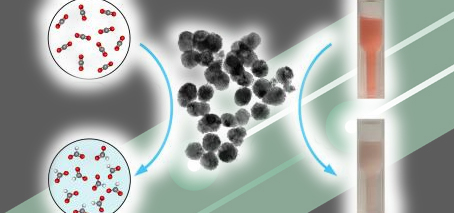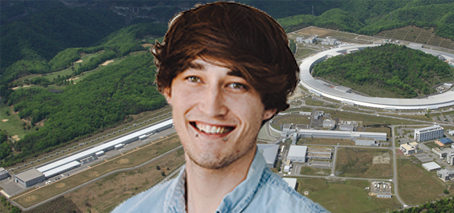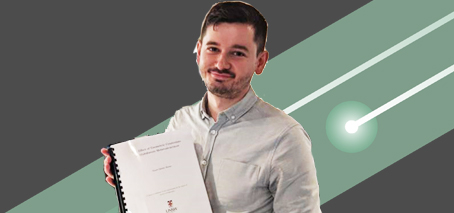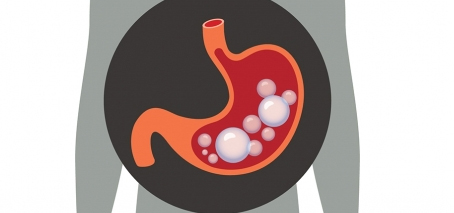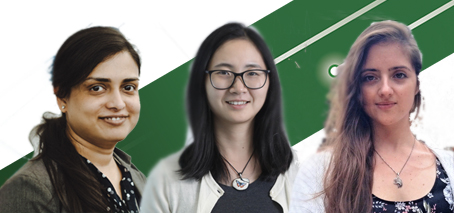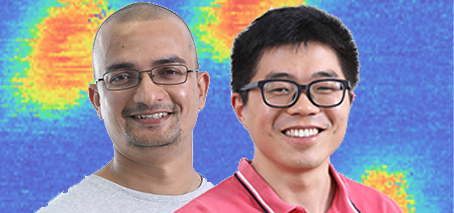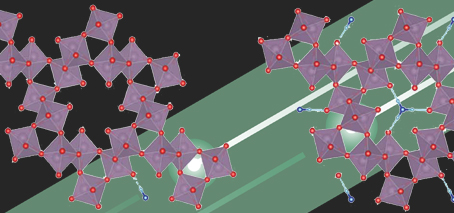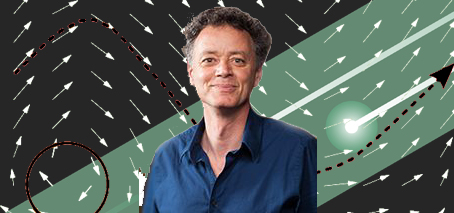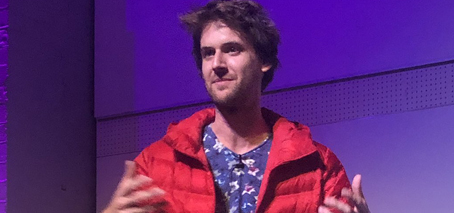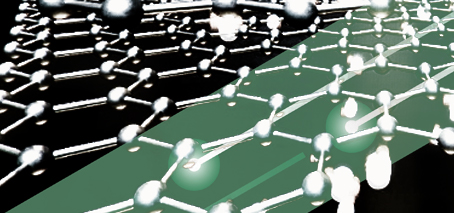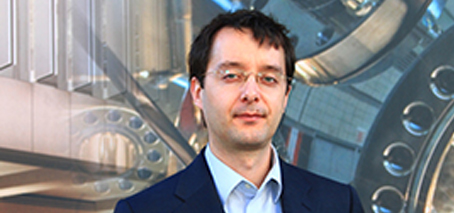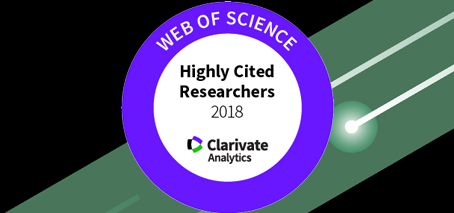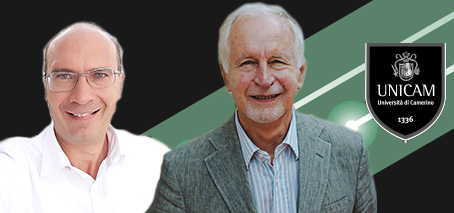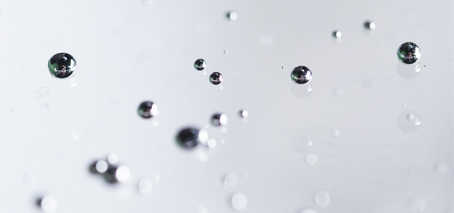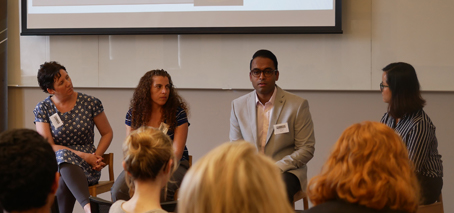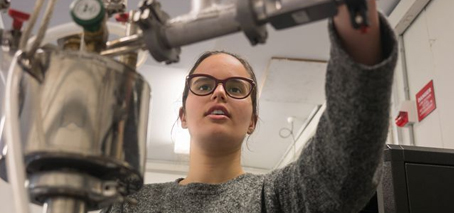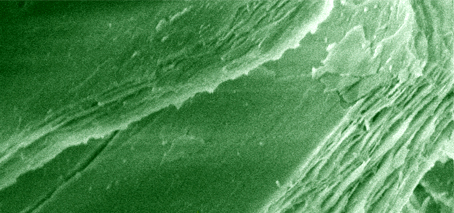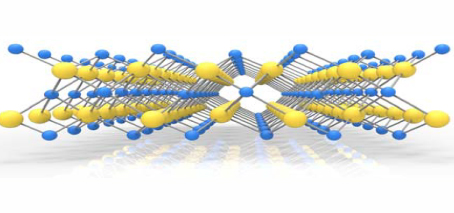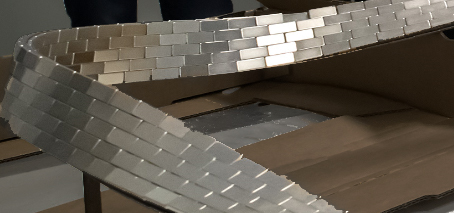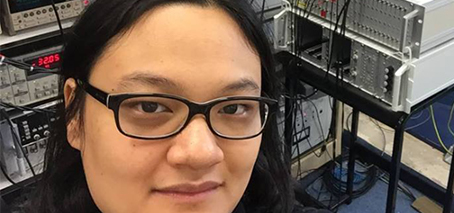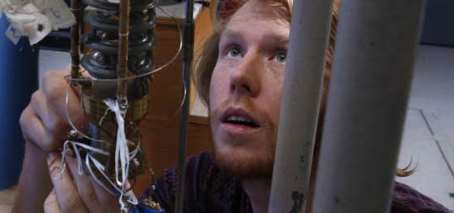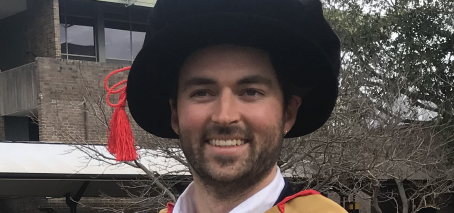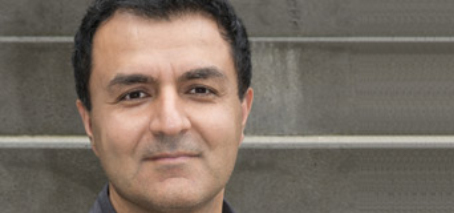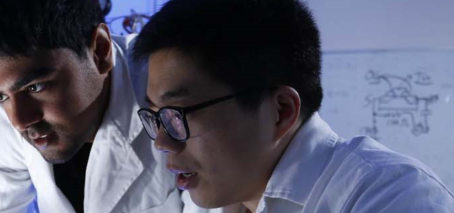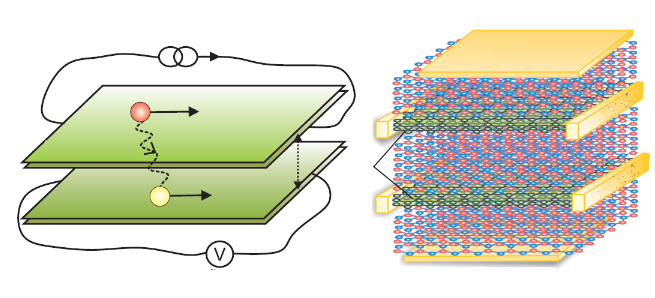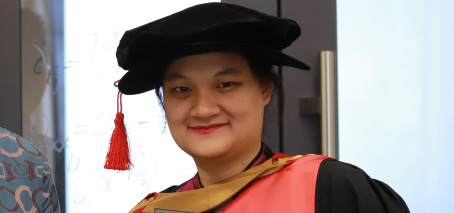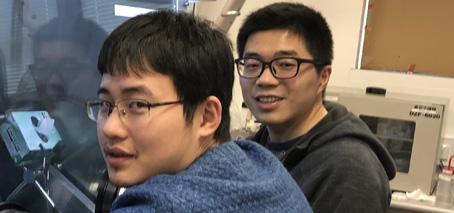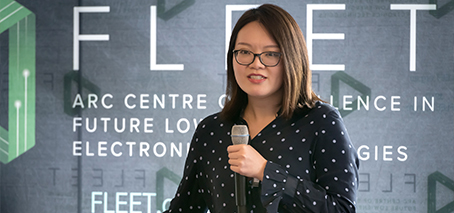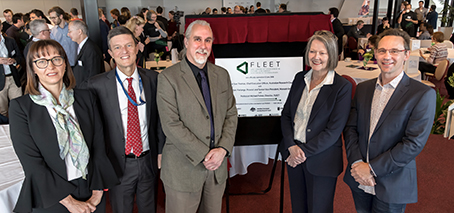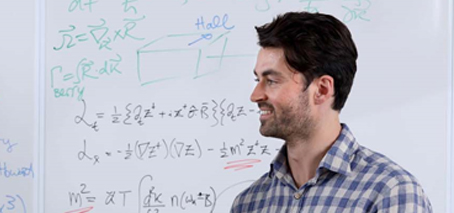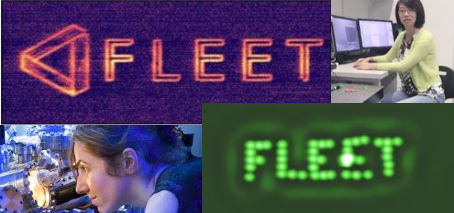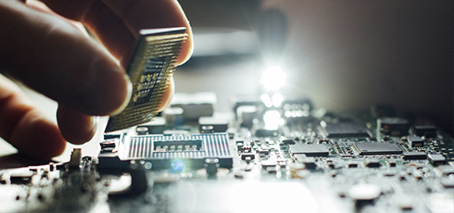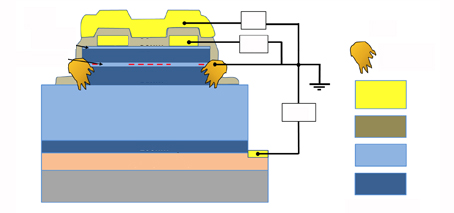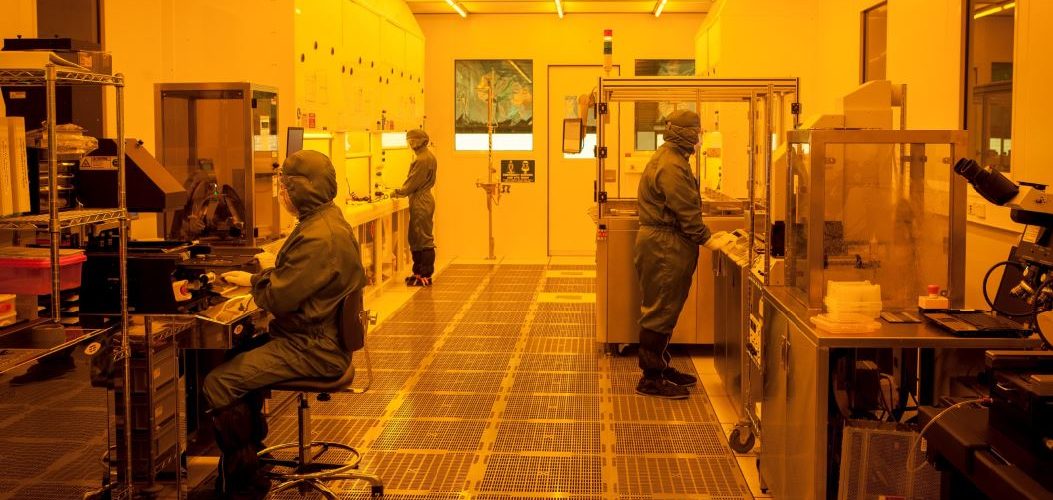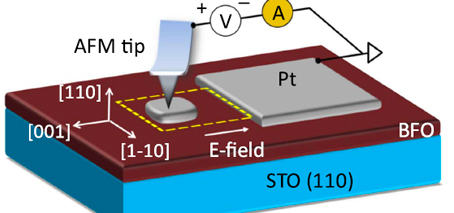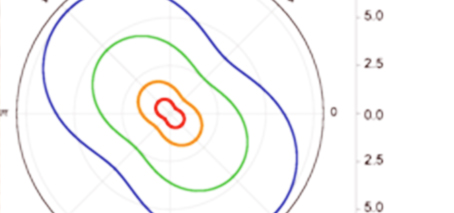Forget the laboratory, substances that can solve environmental problems by capturing carbon dioxide, decontaminating water and cleaning up pollutants can be easily created in a kitchen, a UNSW Sydney study shows. In a paper published today in Nature Communications, UNSW chemical engineers shone a light on the mysterious world of liquid metals and their role as catalysts to speed up chemical …
UNSW student focuses kilometre-long laser
UNSW PhD student focuses one-km long laser to probe electronic structure Measuring femto-second responses on X-ray Free Electron Laser (XFEL) One of the highest energies of any synchrotron in the world. “It’s a pretty surreal being at the pointy end of almost a kilometre-long laser,” says UNSW PhD student Oliver Paull. “Not because of any danger from the laser (even …
Recognition of hard work, PhD submitted – congratulations Stuart Burns, UNSW
Congratulations to FLEET PhD student Stuart Burns, who submitted his PhD thesis recently, and whose hard work was rewarded by a rare UNSW scholarship to continue to carry out research while his thesis is being reviewed. Stuart is a PhD candidate working with Prof Nagy Valanoor and Dr Daniel Sando at UNSW to study the functional behaviours of ferroelectrics at …
FLEET/UNSW scientists sharing their passion for science: Science outreach in August
—by Cecilia Bloise, Node Coordinator, UNSW There’s nothing like a strong dosage of outreach to get the ‘cats out of the box’ into the public sphere. The FLEET Centre of Excellence invests significant resources into science-outreach, aimed to inspire stronger engagement with science across all levels of the community, from primary and secondary school students to the broader population. Beyond …
Gutsy effort to produce comprehensive study of intestinal gases
A source of embarrassment to some, or pure comedy to others, flatulence and the gases of the intestines are increasingly seen as playing an important role in our digestive health. A paper led by UNSW Sydney and published in Nature Reviews Gastroenterology & Hepatology has examined all available literature on gastrointestinal gases, their interactions with the microbiome of the gut, …
Three new research fellows join FLEET
FLEET welcomes three new research fellows, who will be working in diverse roles across the Centre: Dr Semonti Bhattacharyya (Monash) Dr Peggy Qi Zhang (UNSW) Dr Iolanda Di Bernardo (Monash) The three new positions have been filled via the Women in FLEET fellowship, which forms part of FLEET’s mission to create workplace diversity and retain female scientists within STEM. Dr …
First observation of native ferroelectric metal
In a paper released today in Science Advances, UNSW researchers describe the first observation of a native ferroelectric metal. The study represents the first example of a native metal with bistable and electrically switchable spontaneous polarization states – the hallmark of ferroelectricity. “We found coexistence of native metallicity and ferroelectricity in bulk crystalline tungsten ditelluride (WTe2) at room temperature,” explains …
Collaboration unlocks new magnetic properties for future, faster, low-energy spintronics
• RMIT–UNSW collaboration combines theory, experimental expertise • ‘Spintronic’ applications promise faster, more efficient computing • New magnetic properties of 2D Fe3GeTe2 (FGT) discovered A theoretical–experimental collaboration across two FLEET nodes has discovered new magnetic properties within 2D structures, with exciting potential for researchers in the emerging field of ‘spintronics’. Spintronic devices use a quantum property known as ‘spin’, in …
Meet molybdenum, an acid-free route to future Hydrogen power?
Molybdenum based compounds could provide key to hydrogen production for future zero-emissions energy RMIT/Monash collaboration opens promising route towards alkaline hydrogen production A FLEET study combining experimental expertise at RMIT with theoretical modelling at Monash University opens a new route towards efficient, cost-effective production of hydrogen. Researchers discovered that ammonium-doped, hexagonal molybdenum oxide (MoO3) displays extremely promising electronic and material …
Deciphering the fundamental physics of ferroelectricity at the nanoscale
Welcome new AI Laurent Bellaiche Welcome to Prof Laurent Bellaiche, whose ongoing research collaborations with FLEET are recognised by him becoming a Centre Scientific Associate Investigator. At the University of Arkansas (US), Prof Bellaiche leads first-principles-based theoretical studies of ferroelectrics, magnetic compounds, multiferroics and other semiconductors. He has co-authored over 310 refereed journal articles, his publications have been cited more …
Topological physics finds Famelab success
Congratulations to FLEET’s Sam Bladwell (right, UNSW), who won the NSW semifinal of Famelab, talking about study of electron spin, and will now compete in the finals in Perth on May 8th. Topological physics has done particularly well in this year’s Famelab, with FLEET associates Dr Semonti Bhattacharyya and Dr Antonija Grubisic-Cabo (Monash University) also qualifying for the Victorian semifinals. …
Welcome new FLEET crew members
We have recently welcomed a number of new Centre members, including: New PhD students (in most cases, having decided to continue with us after their FLEET Honours projects): Bernard Field with Agustin Schiffrin (Monash) Oliver Stockdale with Matt Davis (UQ) Yik-Kheng Lee with Jared Cole (RMIT) Zeb Krix with Oleg Sushkov (UNSW) Mitchell Conway with Jeff Davis (Swinburne) Lina Sang with Xiaolin Wang (UOW) New …
I can’t believe it’s not graphene: nanoengineering artificial graphene
New facility improves study of ‘artificial graphene’ at FLEET ‘Like driving a new Maserati!’ The amazing electrical properties of graphene and other 2D, atomically-thin crystals are due to the symmetry of their lattice structure. For example, it is graphene’s famous ‘honeycomb’ lattice that causes electrons to act as they were massless – moving about 70 times faster than in silicon …
Topological defects could be key to future nano-electronics
• Ferroic and multiferroic topological structures offer exciting potential in future nanoelectronics • Commentary piece published this week in Nature Materials The connection from fridge magnets to cutting edge materials science is shorter than what one might expect. The reason why a magnet sticks to your fridge is that electronic spins or magnetic moments in the magnetic material spontaneously align …
Three FLEET researchers in Clarivate highly-cited researchers list for 2018
Congratulations to: Michael Fuhrer (Monash University) in the fields of Materials Science; Physics Kourosh Kalantar-zadeh (UNSW and RMIT) in Chemistry; Engineering Qiaoliang Bao (Monash University) in Materials Science; Optics; Physics. The Clarivate Analytics list identifies researchers ranking in the top 1% by citations for their field. Now in its fifth year, the citation identifies influential researchers as determined by their …
New Australia–Italy collaboration: FLEET partners with University of Camerino
FLEET is pleased to announce a new partnership with the University of Camerino (Italy), which will exploit strengths of both groups in the study of exciton superfluids. The University’s Professor Andrea Perali and Professor David Neilson join FLEET as new Partner Investigators. Professors Perali and Neilson study the theory of of exciton superfluids,and since 2012 have collaborated with FLEET’s Deputy …
UNSW: Electronic Materials
Application close 1 December 2018 Opportunity exists for a researcher with experience in working with electronic materials, either in their synthesis, characterisation and device fabrication. The academic level A or B (depending on experience) fellow will be working with FLEET Chief Investigator Professor Kourosh Kalantar-zadeh at UNSW. The successful candidate will be expected to: Conduct independent research on electronic materials with limited …
YouRforum UNSW
Where can your PhD take you? And how can you maximise your potential future? Because most PhD graduates will not end up in academia, FLEET assists HDRs in developing a diverse skills base to maximise future career opportunities. In 2018, FLEET’s YouRforum (Young Researchers Forum) was expanded to UNSW, where a panel of science PhDs discussed career options for STEM …
First year physics students exploring future electronics
First year physics students enthusiastic to explore ‘new’ physics Measuring quantum Hall effect with liquid helium-3, a Cold War side-product Window to topological materials and future electronics UNSW first year physics students have been measuring the quantum Hall effect (QHE), a relatively new piece of physics recognised by the 1985 Nobel Prize in Physics, which requires precision experimental setup. When …
Quick and not-so-dirty: a rapid nano-filter for clean water
FLEET researchers have designed a rapid nano-filter that can clean dirty water over 100 times faster than current technology. Simple to make and simple to scale up, the technology harnesses naturally occurring nano-structures of aluminium hydroxide that grow on liquid metal gallium. The researchers behind the innovation at RMIT University and UNSW have shown it can filter both heavy metals …
Ferroelectric switching in Indium(III) selenide: potential for ultra-low energy electronics
The discovery of new ferroelectric properties in the novel, layered material Indium(III) selenide (β’-In2Se3) enhances this material’s candidacy for non-volatile memory and low-power electronic and optoelectronic switches. FLEET researchers at Monash University and UNSW were on the Australian-Chinese team that confirmed in-plane ferroelectricity in the material, β’-phase In2Se3. In2Se3 belongs to a class of layered materials known as van der Waals …
Supercool, superconducting Mobius track helps communicate FLEET science
A super-cooled, superconducting Mobius-track impresses the crowds, helps embed FLEET science As a cool science demo, FLEET’s superconductor Mobius track ticks all the boxes: liquid nitrogen – tick. Superconductor – tick. Cool shape – tick. Relevance to the science – tick tick tick. The track features 1500 neodymium magnets, fixed into the shape of a Mobius strip, so that a …
Putting a New Spin to the Hole Story
Controlling hole spin for future quantum spin-based devices, topological materials The ‘spins’ of electrons (and holes) in semiconductors have potential applications in spintronics, spin-based quantum computing, and topological systems. A particle’s spin is its intrinsic angular momentum. In a magnetic field, the spins of electrons or holes becomes oriented either parallel (‘spin-up’) or anti-parallel (‘spin-down’) to the field direction – just …
Building artificial atoms using holes
Hole-based artificial atoms could be key to spin-based qubit First isolation of one individual hole in a silicon MOSFET quantum dot A UNSW study published this week resolves key challenges in creation of hole-based artificial atoms, with excellent potential for more-stable, faster, more scalable quantum computing. Artificial atoms in quantum computing The spin states of electrons confined to semiconductor quantum …
Congratulations Harley Scammell: PhD recognised
Exciting new states of quantum matter enlisted to important environmental challenges FLEET’s Harley Scammell’s outstanding PhD recognised by UNSW The thesis “Interplay of quantum and statistical fluctuations in critical quantum matter” will be published by Springer in hardcover and ebook. “It’s really great to have this research recognised by UNSW”, says Harley. “Hopefully, having the thesis published at Springer will make this …
Congratulations Kourosh Kalantar-Zadeh, ARC Laureate Fellow
Congratulations to FLEET’s Kourosh Kalantar-Zadeh — named an Australian Research Council Laureate Fellow today. Kourosh’s significant influences in engineering include two-dimensional (2D) transition metal compounds, liquid metals, microfluidics, sensors, electronic devices and medical systems. He is an expert in chemical and biochemical sensors, nanotechnology, microsystems, materials science, electronics, gastroenterology, medical devices and microfluidics, and has made internationally-recognised contributions to the …
Why 2D? Measuring thickness-dependent electronic properties
Why 2D? What is it about two-dimensional materials that makes them so interesting for FLEET? FLEET UNSW/Wollongong collaboration finds transition point from 3D to 2D properties Constraining the movement of charge carriers (electrons or holes) to two dimensions unlocks unusual quantum properties, resulting in useful electronic properties. Although we refer to the layers within such materials as ‘2D’, they are …
Puzzling results explained: a multiband approach to Coulomb drag and indirect excitons
Taking a multiband approach explains ‘electron-hole reverse drag’ and exciton formation Mystifying experimental results obtained independently by two research groups in the USA seemed to show coupled holes and electrons moving in the opposite direction to theory. Now, a new theoretical study has explained the previously mysterious result, by showing that this apparently contradictory phenomenon is associated with the bandgap …
Love of maths leads to spin PhD: Congratulations Dr Elizabeth Marcellina
Maths and spin: key to new electronics A love of maths brought Elizabeth Marcellina to the study of quantum and condensed-matter physics, where her recently completed PhD research studied possible routes to faster, more efficient electronics, by harnessing the ‘spin’ of the carriers in common semiconductors. As Moore’s law is coming to an end, much effort has been devoted to …
Centre collaboration combines material expertise
FLEET RMIT—UNSW collaboration measuring transport properties of van der Waals heterostructures FLEET PhD Cheng Tan (RMIT) visited UNSW’s labs in May to perform magnetic coupling measurements on 2D ferromagnetic crystals. The visit was reciprocated this month with FLEET Research Fellow Feixiang Xiang (UNSW) visiting RMIT to construct van der Waals structures for studying of 2D topological systems. This collaboration between …
The case for FLEET: 8% of global electricity now consumed by computing
The information technology revolution has improved our lives, and we want it to continue. For example, our smartphone has become one of the most important devices of our everyday life: we use it to access up-to-date weather predictions, to plot the best route through traffic, and to watch the new series of House of Cards. And we expect it be …
Launch of FLEET Centre of Excellence to tackle hidden energy costs of computing
Official launch: Australian Research Council Centre of Excellence in Future Low-Energy Electronics Technologies 12 June 2018, 11 AM New Horizons Building, Monash University, Clayton We have an insatiable appetite for computing. But our ongoing need for computation is burning more than 5 percent of global electricity. And that figure is expected to double each decade. A new Australian Research Council …
FLEET postdoc: Fulbright Scholarship to fund superconductivity research at Harvard
Congratulations to FLEET UNSW postdoc Harley Scammell who has been awarded a Fulbright Scholarship to work with world-renowned theoretical physicist Subir Sachdev at Harvard University on the mechanisms behind superconductivity – an exotic quantum phase of matter. The Australian-American Fulbright Commission promotes education and cultural exchange between Australia and the US, By the completion of the Fulbright program, researchers around …
Micro branding: creating microscale and nanoscale FLEET banners
FLEET researchers taking an innovative, even ‘playful’, approach to their science have created a couple of unique and interesting branding displays for the Centre. >>>FLEET PhD student Fan Ji developed this micro-sized logo (right) at UNSW. The FLEET logo is etched onto the two-dimensional interface between two materials, in letters only a few thousandths of a millimetre high, using bias-assisted …
UNSW: Mesoscopic devices in oxide heterostructure based 2D electron systems
Supervisor: A/Prof. Alex Hamilton The conducting interface between the two insulating oxides LaAlO3 and SrTiO3 (LAO/STO) exhibits many intriguing properties such as high mobility, a gate-tunable superconducting phase, ferroelectricity and ferromagnetism. The aim of this project, working in in close collaboration with FLEET colleagues in Materials science at UNSW, is to develop new techniques for fabricating nanoscale devices at the …
PhD Project: Quantum transport in hybrid semiconductor-superconductor devices
Supervisor: A/Prof. Alex Hamilton Topological materials, such as topological insulators, Weyl semimetals, and strongly spin-orbit coupled semiconductors, have attracted considerable attention due to their potential in spin electronics and quantum computation.A recent development are hybrid superconductor-semiconductor systems, which can support zero energy Majorana modes. In this project we will fabricate devices superconductor-semiconductor and superconductor-2D devices using electron beam lithography, and …
FLEET researchers get a $4.6m boost in ARC funding round
This month’s ARC funding round saw FLEET research and researchers across five universities awarded additional funding. Across eight separate grants, almost $4.6m new research funding went to projects and facilities led by or involving FLEET researchers or directly contributing to FLEET’s search to develop ultra-low energy electronics and boost related areas of research. Two projects in particular will be key …
Research in Topological Materials
FLEET researchers undertake various research projects in the area of Topological Materials. If you have a project that would fit this theme, find information about a potential supervisor here: PROF. MICHAEL FUHRER Experiments on electronic devices made from novel two-dimensional materials such as graphene, layered transition metal dichalcogenides, topological insulators. Scanning tunnelling microscopy. Surface science A/PROF. NIKHIL MEDHEKAR Computational mechanics …
Current-carrying holes confined to one-dimension show unique spin in UNSW study
UNSW researchers solve a 10-year-old mystery in the way nanoscale transistors work. Half of all the transistors in your iPhone use positively-charged ‘holes’, rather than negatively-charged electrons to operate. At university, we teach undergraduates that holes are quasiparticles, basically ‘missing electrons’ – a bit like the bubble in a spirit level, or the missing chair in a game of musical …
PhD Application Information – UNSW
Application Apply by 2 February. Eligibility Before you can apply for your research higher degree program, it is critical that you determine whether you are eligible for admission. To determine your eligibility, you must use the UNSW HDR Self-Assessment Tool. The Self-Assessment Tool provides you with an indication of your eligibility for admission to the UNSW research higher degree programs, …
Materials one atom thick & nanotransistors: FLEET features in nano edition
FLEET features in this month’s annual ‘nano’ edition of the Australian Manufacturing Tech magazine. The article looks at growth of atomically thin and other novel materials and nanofabrication, with a particular focus on partnerships. Atomically thin material projects presented include semiconductor fabrication at RMIT University (Lan Wang) and the University of Wollongong (Xiaoliang Wang) and molecular beam epitaxy (Mark Edmonds …
‘Agile’ circuits: new study a step towards ferroelectric domain wall nanoelectronics
A UNSW study published last Friday presents an exciting step towards a novel form of electronics based on nano-scale, ‘disappearing’ conduction paths that could allow for extremely dense memory storage. It’s based on domain walls, which are atomically sharp topological defects separating regions of uniform polarisation in ferroelectric materials. The domain walls are electrically conductive, while the surrounding of the wall …
New spin-orbit coupling analysis agrees with experiment
A study by FLEET’s UNSW researchers looked at spin-orbit interaction at the two-dimensional interface between common semiconductor materials. A new semi-analytical method was developed for analysis. Spin-orbit interaction (SOI), is the interplay between electrons’ inherent angular momentum (their quantum spin) and their orbit around an atom’s nucleus. This interaction is key to the function of topological materials, which are studied …
- Page 2 of 2
- 1
- 2

